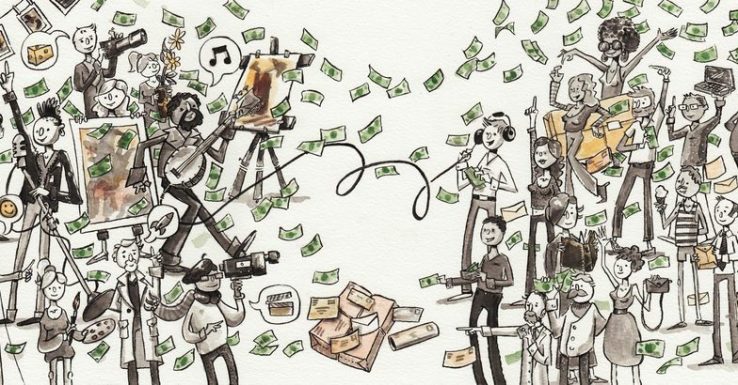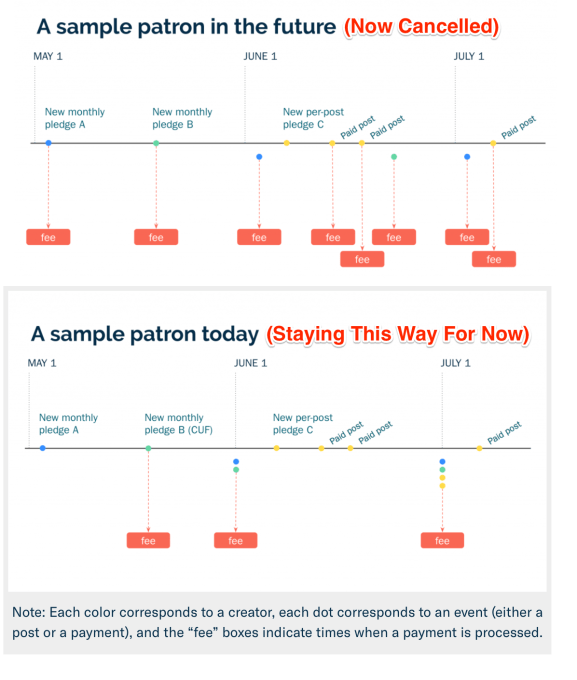Why content crowdfunder Patreon is halting its hated fee change

Overhauling the creative economy turns out to be quite tricky. Following massive backlash, Patreon is at least temporarily pausing its plan to change its payment processing fee structure on December 18th from charging creators 2-10 percent on the first of the next month to charging patrons 2.9 percent plus $0.35 per transaction upfront and on the monthly anniversary of their first pledge beyond the 5 percent Patreon takes. “We messed up. We’re sorry, and we’re not rolling out the fees change,” CEO Jack Conte writes. He tells me, “We got in the way of the creators and their fans.”
The subscription content crowdfunding company’s goal was to prevent patrons from being able to sign up and get access to exclusive content and then cancel their subscription before paying on the first of the next month, and to avoid users being charged immediately and then again on the first of the next month so they’d essentially be doubled billed if they pledged near the end of the month. Pro-rating wouldn’t work either since patrons could sign up for a big $100-a-month subscription, experience super-premium access to content, then cancel a day later having only paid $3.

Patreon CEO Jack Conte
But the problem with the fee change was that it prevented batching payments so patrons would pay just one processing fee for all their different pledges, and instead charged patrons the fee on every different campaign they support. This significantly boosted fees for patrons who only pledge a dollar or two per campaign, and ones that pledge to multiple campaigns and therefore get charged multiple fees. Patreon also admits it didn’t get enough direct feedback from creators and rushed a mere two-week timeline for implementing the change.
So after a painful week of calls with creators who said patrons had cancelled their subscriptions to avoid the higher fees, Patreon is halting the change until it can receive more feedback and find a better path forward. The retreat shows a level of maturity at the company, even if also some lack of foresight.
Patreon raised $60 million earlier this year at a $450 million valuation to build out more monetization tools for content creators, from video makers and comedians to illustrators and models. With $107 million in funding, many assumed Patreon was on stable enough financial footing to avoid having to change from its existing fee structure where it takes a mere 5 percent rake — compared to typical 30 percent charged by platforms like Apple and Google’s App Stores and 45 percent charged by Facebook and YouTube for ad revenue shares.

But “the system that my co-founder came up with 4 years ago in 25 days” needs to be updated. Patreon has to abide by credit card processing rules while keeping enough revenue to stay alive. Conte tells me Patreon still has a bunch of new premium tools in the works for creators, a storefront for selling merchandise for example, that will be unveiled in the coming year and will help it earn more money to keep the platform sustainable. But many creators surely construed the payment structure change as a way for Patreon to jack up fees.
The episode demonstrates just how tenuous it can be to alter the foundations of monetization systems that independent creators rely on. YouTube has had its own problems with creator backlash after pulling ads and demonetizing more videos and creators in order to appeal to family friendly advertisers. Conte tells me the plan going forward is to “work more with creators one-on-one, show them the problems that we’re trying to address, get more feedback earlier, give creators more lead time, do more qualitative research . . . and honor the idea of letting creators own their relationships and run their businesses the way they want to run them.”
After speaking at length with Conte, though, Patreon seems stuck between a rock and a hard place. Keeping the fee structure sustainable for the startup, preventing creators from having their content accessed without fair payment and avoiding overcharging patrons for processing fees or fractions of a month of access seems somewhat intractable, otherwise the company would have come in with a better solution than its first attempt. We’ll see if it can create something that works for everyone.